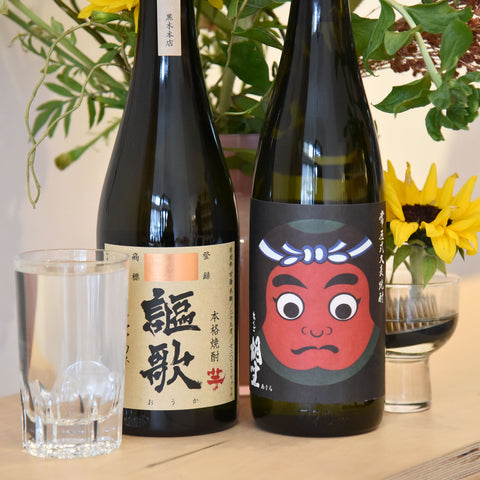 Sake Gumi is our monthly sake subscription service with 200 members throughout the country. Join today!
Sake Gumi is our monthly sake subscription service with 200 members throughout the country. Join today!
As we approach the end of 2023, I look forward to getting cozy in my big slippers and thick sweaters while sipping on soft and gentle sakes made with yukidoke (snow melt). Luckily, sakes made with snow melt are not hard to find as Japan is a mountainous island chain, famous for its soft water, and powdery ski slopes. Yukidoke used for sake does not directly flow from the mountain into the tanks of sake, instead it develops its character over decades. Nobuki Matsumoto, the toji of Shirataki Shuzo explains “After the snow melts, it takes several decades for the water to reach the underground veins from the surface of the earth, but the water is dug through wells and pumped up to be used for sake brewing.” Similarly, Kunihiro Ono at Yoshinogawa Brewery says, “They penetrate deep into the earth and undergo repeated filtration over many years, creating a clear, pure and cold underground water vein.”
All four breweries featured this month are located in snow country alongside dramatic mountain ranges. Chikuma Nishiki Sake is located along Asama mountain range in Nagano prefecture, and Ippongi Sake Brewery stands in the shadow of the sacred mountain Hakusan in Okuechizen, to the north-east of Fukui Prefecture, while both Shirataki Shuzo and Yoshinogawa Brewery, are located in Niigata, famous for getting record amounts of snow every year. In addition to providing an abundance of soft water, these bitterly cold winters inhibit unwanted bacterial behavior during the brewing process. Kakutaro Kubo, president of Ippongi Sake Brewery also adds, “Sake-specific rice strains (i.e. Gohyakumangoku) are perfectly adapted to the heavy snowfall and terrain.”
Water hardness is calculated by converting the amount of calcium and magnesium in water to calcium carbonate. Soft water is defined as having less than 60 mg/L of calcium carbonate, and all of the makers here emphasize that soft water allows their sakes to achieve a lighter taste and soft mouthfeel. If you remember the theme from October, Miyamizu, we tried sakes made with hard water. Matsumoto sums it up by saying, “Sake made using hard water is suitable for making heavy, dry alcohol. On the other hand, sake made using soft water tends to have a beautiful and gentle taste.” Ono of Yoshinogawa adds, “Soft water takes longer to ferment than hard water, so it often ends up with a finer, lighter flavor.” I find that the sakes this month have notes of mochi and light-as-air angel food cake.
Kubo describes the sensation of sake made in snow country poetically, “Sake with majesty that fades away like a dream.” That might be the way I’d like to remember 2023.
Kanpai,
Yoko, Co-Founder + Sake Director at Umami Mart
+++
LEVEL 1

Jozen White Junmai Ginjo
Shirataki Shuzo (Niigata, Japan)
Seimaibuai: 55% Gohyakumangoku, SMV: +4, Acidity: 1.2
“Our goal is to create a sake that is as smooth and transparent as melting snow,” says Matsumoto-san of Shirataki Shuzo. The bottle, designed by P Design Laboratory, tried to recreate the sparkling appearance of snow, resulting in the faceted surface. Enjoy aromas of whipped cream and flavors green melon and apples. This sake is suited for seafood, and recommended to pair with pasta alle vongole. Matsumoto recommends finishing the dish with a few spritz’ of Jozen White to bring out the umami of the seafood. Drink this sake warm or at room temperature.

Denshin Yuki Junmai Ginjo
Ippongi Kubohonten (Fukui, Japan)
Seimaibuai: 55% Gohyakumangoku, SMV: N/A, Acidity: N/A
This sake is named yuki, or snow, to acknowledge the melting snow that flows down through the woods that is used for brewing. Kakutaro Kubo, president of Ippongi Sake Brewery says, “Our brewery in the city of Katsuyama stands in the shadow of the sacred mountain Hakusan in Okuechizen. This snow country is known for its particularly heavy snowfall and supplies all the water for the plain that stretches across the north of Fukui Prefecture.” The resulting sake is light gold, with notes of mochi, cornbread, cherry, and rootbeer. Kubo recommends having this sake with any dish that features a citric element, for example, steamed prawns or raw oysters with lemon. I enjoyed this sake slightly warmed (110°F) with stir-fried lotus root dressed with umeboshi.

Yoshinogawa Gokujo Ginjo
Yoshinogawa Sake Brewery (Niigata, Japan)
Seimaibuai: 55% Gohyakumangoku, SMV: +7, Acidity: 1.2
Kunihiro Ono of Yoshinogawa Sake Brewery describes the water used for brewing their sakes, “ We use groundwater drawn from a well on the premises (a shallow well approximately 10m deep) from Yoshino River. The water used for brewing is named ‘Tenka Kanrosen.’ The water is soft and is low in iron and minerals, which requires a longer fermentation time.” Low temperature, longer fermentation leads to a clean finish. Enjoy this savory sake slightly warmed to enjoy notes of earthy porridge, sassafras, and melon rinds. Pair with foods that are full of umami including raw oysters with lemon and fresh burrata dipped in soy sauce.

Kizan Sanban Junmai Ginjo Nama Genshu
Chikuma Nishiki Shuzo (Nagano, Japan)
Seimaibuai: 55% Miyama Nishiki, SMV: -16, Acidity: 3.0
We offered this sake at the Fifth Taste event last month and it sold out immediately. Luckily I had procured enough bottles for everyone in Level 2 prior to its arrival stateside. The name Kizan means “to return to the mountains.” Chikuma Nishiki Brewery is located in the Alps of Nagano Prefecture. This juicy sake proves its complexity by offering flavors of licorice, tart green apples, and sweet coconut. Enjoy this viscous namazake chilled in a flute to highlight its bright and slightly effervescent texture. The high acidity in this sake is an ideal pairing with heartier foods like rare steak, grilled tofu, and sukiyaki.




Comments (0)
There are no comments for this article. Be the first one to leave a message!